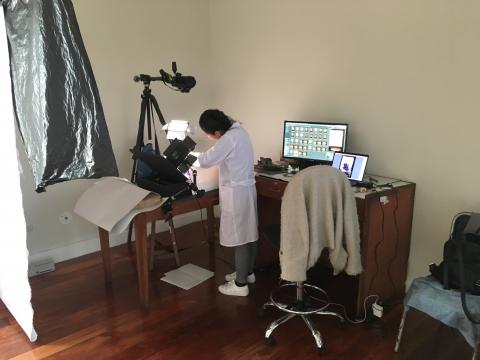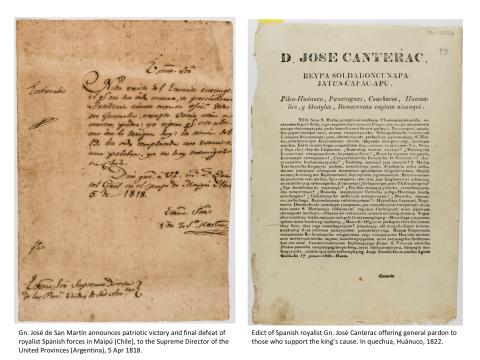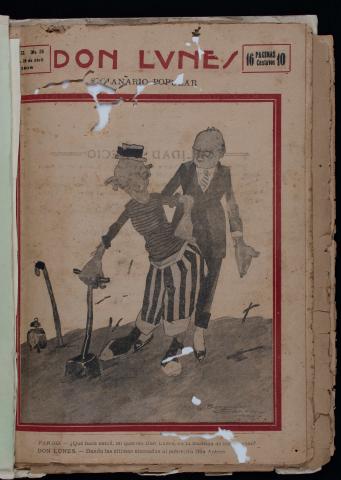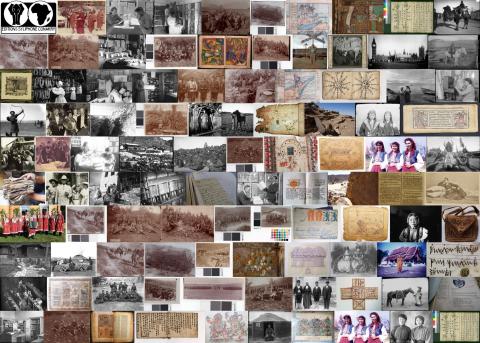
Aims and objectives
This project will build on the achievements of the previous EAP project conducted by the Institute of Ethnomusicology. On that occasion, three provinces of Peru were covered: Cajamarca, Ancash and Junín - all located to the north of Lima. This project will cover the Departments of Ayacucho, Arequipa and Puno, located to the south of Lima with their distinctive regional variations.
In the Andean world, cultural representations are, in the absence of written literature, the primary expressions of the Andean worldview and the aspirations of its people. These expressions are fundamentally drama, music and ritual-dance defined in a broad sense. The best way to record and remember these cultural representations is through audiovisual means, since these materials are the only visual testimony of Andean expressive culture in the twentieth century. Audiovisual means have been used for decades in the Andes by local intellectuals who took responsibility to record the expressive culture of their own towns.
The physical condition of the audiovisual materials that are kept in Andean Peru generally varies from a careful organisation of the material to the careless storage in cardboard boxes in private homes. These private collections in the Andes do not have suitable environments for the preservation of this type of material. Most of the collectors are local intellectuals in their own towns who dedicate their lives to document by audiovisual means the expressive cultures of their fellow villagers, but who do not have the means to preserve them adequately for future generations. Most of these collectors are older senior citizens, and those who have passed away have left their holdings to their families. Some of these families are eager guardians of their legacy, but others ignore the cultural value of these materials.
If these audiovisual materials in the Peruvian provinces are not relocated, digitised, or both, they will be lost in time to deterioration, or oblivion.
This new project is an opportunity to apply all the experience gained during the previous project to other cultural regions of the country. Peru is a multicultural nation; more than 60 native languages are spoken in Peru besides Spanish. Most of them are in the Peruvian jungles, but even in the Quechua areas there are six different Quechua dialects that are distinct from each other. Modern Peru is divided in 24 Departments, and each Department includes a variable number of provinces.
In this project covering the Departments of Ayacucho, Arequipa and Puno, the focus will be on fieldwork in the city capitals, because in the rural areas there are few possibilities of finding audiovisual materials. Thanks to the previous experience, most of the fieldwork will consist of short field trips designed to locate important collections and establish a relationship with the collectors or their heirs. The previous project established it was better, and cheaper, to bring the materials to the offices in Lima. The reputation of the university throughout Peru makes this possible.
The original materials will be returned to their owners after they have been digitised in the audiovisual labs of the Institute of Ethnomusicology (IDE) in Lima, Peru - except in those cases where the owners wish to donate permanently their materials. The IDE will keep one digital copy of each item in its audiovisual archives, and send another digital copy to the British Library.
Outcomes
In the Puno region, the project team worked in Puno city and Juli city. 1,631 images were digitised, including slides, negatives, black and white photographs and colour photographs. More than 69 hours of film footage were digitised from 8mm and VHS formats, covering traditional dances and other social festivities, and more than 100 hours of traditional music records were digitised.
The main topic of this visual collection was the celebration of the Candelaria Virgin, the most important traditional celebration from the altiplano region and one of the greatest festivities in Peru. There were also other types of social celebrations and religious festivities.
In the Arequipa region, the project was unable to find any significant material regarding Andean cultural expressions in audiovisual format. This was a very particular situation and highly different from other regions. Apparently, this kind of record was almost non-existent and neither local photographers or scholars have focused in the documentation of Andean culture. The interest for recording these Andean expressions is relatively new. In past decades when talking about indigenous peoples, references were made to Puno, thus neglecting the existence of indigenous population in Arequipa’s own territory.
Despite this, Arequipa had some very important photographers that gained fame and reputation in the mid-twentieth century. These photographers developed a certain aesthetic visual style that marked a particular trend. Unfortunately though they did not incorporate ethnographic topics. Eventually, in Arequipa the project did digitise nearly 600 images from slides, negatives, black and white photographs and colour photographs and 1:35 hours of film footage related to religious celebrations from Colca Valley and traditional dances from the region.
In the Ayacucho region, the project digitised more than 800 images from slides, negatives, black and white and colour photographs; more than 20 hours of film footage in VHS format and 75 hours of traditional music from audio cassette format. The topics here have been more varied with a high inclination to festivities linked to agriculture and other religious and social celebrations.
When looking at the collections as a whole, there are gaps in some of the metadata of information that is not known anymore, because the owners or specialists cannot recognise the contents of the documents. On the other hand, and following the aims of the project of revalorising the Andean culture and bringing some inputs for the construction of a collective memory, the project conducted in-depth interviews with photographers, collectors and scholars in Puno, Arequipa and Ayacucho. These interviews focused on the life of the photographers, the role of the local photographer in the construction of a regional cultural memory and other aspects of the importance of building an archive and preserving audiovisual ethnographic material as a strategy to rescue endangered material and endangered cultural expressions.
Almost all the collections were in very bad conservation condition. This material had been stored in very humid, dark and dirty spaces. Therefore, many of the collectors asked for a few weeks to find, order and classify the material they had. Other collectors even with great aptitude to collaborate expressed that they had lost their material in fires, floods, thrown it away or just lost it.
Copies of their own material have been given to individual collectors and a full copy of the material has been deposited with the Institute for Ethnomusicology of the Catholic University of Peru, and the British Library.
The records copied by this project have been catalogued as:
- EAP298/1 Fernando Cáceres Jara Collection
- EAP298/2 Collection of the National Institute of Culture (INC Puno) [1978 - 2006]
- EAP298/3 Eva Cossío Collection. Made up of photographs of native dresss and dances of the Virgin Candelaria festival in the Puno Region. [1950s-1970s]
- EAP298/4 Oscar Bueno Collection [1950-2000]
- EAP298/5 Marcelino Villagra Collection. Made up of photographs of dances from Juli, Puno Region
- EAP298/6 Roberto Llanos Collection. Made up of photographs of Carnival dances and ceremony Ichu rods Chucuito Authorities in the Puno region
- EAP298/7 Hernan Cornejo Collection, consisting of photographs of traditional dances by the APAFIT (Puno Group Folk Art and Theatre) in the Puno region. [1960-2005]
- EAP298/8 Juan Palao Berastaín Collection. Composed of slides of various festivals, ceremonies and activities in rural regions of Puno and Cajamarca
- EAP298/9 Domingo Reboa Collection. Images of everyday life, dancing and staging of Manco Capac, as well as dances of the Virgin Candelaria festival in Puno Region
- EAP298/10 Domingo Reboa Bigi Collection. Made up of diverse images of everyday life and dances of Puno
- EAP298/11 Jaime Flores Collection. Composed of images of local crafts and dances of the Puno Region
- EAP298/12 Percy Miranda Collection. Composed of images of women in traditional costumes and dances in various festivals in Puno
- EAP298/13 Walter Rodriguez de la Riva Collection. Composed of images of indigenous beauty pageant, dances and scenes Apafit Folk group and Titicaca lake
- EAP298/14 Leonidas Cuentas Collection. Composed of a school dances Puno, APAFIT group dances in a coliseum, dances in the Virgin Candelaria Festival and other festivals of Puno. [1950s-1990s]
- EAP298/15 Gerardo Huaracha Collection. Images made up of cleaning ditches, livestock, and other examples of rural jobs. They also depict the festivities of the Colca Valley in Arequipa Region
- EAP298/16 Arnaldo Ramos collection. Composed of images of traditional costumes of Puno and Arequipa, as well as dances of the Feast of the Virgin Candelaria in Puno
- EAP298/17 Grupo Inca Collection. Images formed by several of the contestants from the Arequipa Region who participated in a photo contest organized by the institution Grupo Inca [1917-1991]
- EAP298/18 Ana Maria Pino Collection. Images formed by parties of the Virgin Immaculate and Virgin Candelaria in Puno City [1980-1991]
- EAP298/19 San Cristobal National University of Huamanga Collection. Composed of images of some festivals Huamanga City, as well as by the serenade for anniversary of the university
- EAP298/20 Rural Training Center of the San Cristobal National University of Huamanga Collection. Composed holiday rituals and customs in various towns of the Ayacucho Region [1980-1996]
- EAP298/21 National Institute of Culture Collection - INC Ayacucho. Composed of images of various festivals in the Ayacucho region
- EAP298/22 DIRCETUR-Ayacucho Collection. Composed of images of various festivals, customs and crafts of the region Ayacucho
- EAP298/23 Mario Cueto Collection. Images formed by artisans and villagers, as well as rituals and ceremonies of Ayacucho
- EAP298/24 Agricultural Development Center - CEDAP Collection. Composed of very old pictures Huamanga, Ayacucho Region
- EAP298/25 Maria Matarazo de Benavides Collection. Composed of images of festivals, rituals and customs in the villages of the Colca Valley, Arequipa Region
- EAP298/26 Edilberto Jimenez Collection. Composed of images of various carnival activities in the district of Ayacucho Region Chungui
- EAP298/27 Fermin Rivera Collection. Composed of images of various agricultural activities and the Santa Ana de Tusi festival in Pasco Region, as well as diverse festivals of the Mantaro Valley
- EAP298/28 Nelson Lopez Collection. Composed of images of activities and festive customs of the Huanta Ayacucho region in the twentieth century
- EAP298/29 Fabian Rivera Collection. Composed of images of social life in Ayacucho
- EAP298/30 Oscar Davila Valero Collection. Composed of videos of festivities in the region of Puno, as well as dance competitions and regional performances
- EAP298/31 Ocsa Zacarias Collection. Composed of videos of customs of the Colca Valley, Arequipa Region
- EAP298/32 Miriam Zavala Collection. Composed of videos of customs and dances of Arequipa and some regions of Peru
- EAP298/33 Léonidas Cuentas Collection. Made up of a video containing dances of Virgin Candelaria Festival, as well as performances and visits to historical and archeological center Taquile Island, Puno Region
- EAP298/34 Farmers Training Centre Collection of UNSCH. Composed of community videos and herranza of Kulluchaka and Churumarca and marks animals in the Ayacucho Region
- EAP298/35 National Institute of Culture - INC Ayacucho Collection. Composed of dances and festivities of the Ayacucho region
- EAP298/36 DIRCETUR Ayacucho Collection. Composed of Vilcas Raymi staging and Sondondo Valley tourist circuit in the Ayacucho region
- EAP298/37 Mario Cueto Collection. Composed of the celebration of Easter and the Representation of the dance in Tarpuy, Ayacucho Region
- EAP298/38 Hector Rojas Collection. Composed of the district anniversary of The Morochucos and the Virgin Assumption festival, Ayacucho Region
- EAP298/39 Edilberto Jimenez Collection. Composed of various festivals and farmer rituals, as well as school competitions and interviews on the subversive war in the Ayacucho region
- EAP298/40 Maria Matarazzo de Benavides Collection. Composed of two ethnographic documentaries [1992]
- EAP298/41 Walter Rodriguez de la Riva Collection. Made up of disks of various folklore music of the Puno region
- EAP298/42 Oscar Bueno Collection comprised of popular music from the rural Puno region
- EAP298/43 Ana Maria Pino Collection. Composed of various musical genres of Peru
- EAP298/44 Leonidas Cuentas Collection. Composed of musical genres from various regions of Peru
- EAP298/45 Rural Training Center of UNSCH Collection. Composed of musical genres emitted by radio and musical groups from various communities in the Ayacucho Region
- EAP298/46 Virgilio Palacios Collection. Popular music from the region of Puno
Due to the cyber-attack on the British Library in October 2023, the archives and manuscripts database is currently inaccessible and we are unable to provide links to the catalogue records for this project.





